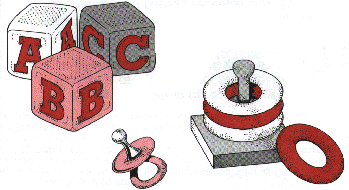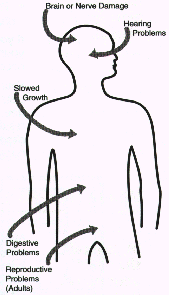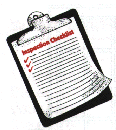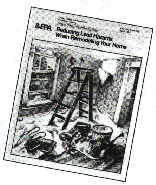and RE/MAX Preferred
Your NJ Results Team!
With multiple offices to better serve you.
LawrenceYerkes.com
Office: 609-654-7300 x1024
Direct: 609-975-9230
Fax: 609-654-7060

|
|
|
H. LAWRENCE
YERKES and RE/MAX Preferred Your NJ Results Team! With multiple offices to better serve you. |
LawrenceYerkes.com |
 |
| Home | Back | Sell | Buy | Rent |Search | Relocate | Resources | Contact Me | Site Map | Translate |

Protect Your Family From Lead In Your Home
[Return to Main Articles Index]

If you think your home has high levels of lead:
 Many houses and apartments built before 1978 have paint that contains lead (called lead-based paint). Lead from paint, chips, and dust can pose serious health hazards if not taken care of properly. By 1996, federal law will require that individuals receive certain information before renting, buying, or renovating pre-1978 housing:
Many houses and apartments built before 1978 have paint that contains lead (called lead-based paint). Lead from paint, chips, and dust can pose serious health hazards if not taken care of properly. By 1996, federal law will require that individuals receive certain information before renting, buying, or renovating pre-1978 housing:
If you want more information on these requirements, call the National Lead Information Clearinghouse at 1-800-424-LEAD.
Lead From Paint, Dust, and Soil Can Be Dangerous If Not Managed Properly.
FACT: Lead exposure can harm young children and babies even before they are born.
FACT: Even children that seem healthy can have high levels of lead in their bodies.
FACT: People can get lead in their bodies by breathing or swallowing lead dust, or by eating soil or paint chips with lead in them.
FACT: People have many options for reducing lead hazards. In most cases, lead-based paint that is in good condition is not a hazard.
FACT: Removing lead-based paint improperly can increase the danger to your family.
If you think your home might have lead hazards, read this pamphlet to learn some simple steps to protect your family.
1 out of every 11 children in the United States has dangerous levels of lead in the bloodstream.
Even children who appear healthy can have dangerous levels of lead.
 People can get lead in their body if they:
People can get lead in their body if they:
Lead is even more dangerous to children than adults because:
 If not detected early, children with high levels of lead in their bodies can suffer from:
If not detected early, children with high levels of lead in their bodies can suffer from:
Lead is also harmful to adults. Adults can suffer from:
*Lead affects the body in many ways.*
Get your children tested if you think your home has high levels of lead.
A simple blood test can detect high levels of lead. Blood tests are important for:
If your child is older than 1 year, talk to your doctor about whether your child needs testing.
Your doctor or health center can do blood tests. They are inexpensive and sometimes free. Your doctor will explain what the test results mean. Treatment can range from changes in your diet to medication or a hospital stay.
Where Lead-Based Paint Is Found
In general, the older your home, the more likely it has lead-based paint.
Many homes built before 1978 have lead-based paint. In 1978, the federal government banned lead-based paint from housing. Lead can be found:
Lead from paint chips, which you can see, and lead dust, which you can't always see, can both be serious hazards.
 Lead-based paint that is in good condition is usually not a hazard.
Lead-based paint that is in good condition is usually not a hazard.
Peeling, chipping, chalking, or cracking lead-based paint is a hazard and needs immediate attention.
Lead-based paint may also be a hazard when found on surfaces that children can chew or that get a lot of wear-and-tear. These areas include:
Lead dust can form when lead-based paint is dry scraped, dry sanded, or heated. Dust also forms when painted surfaces bump or rub together. Lead chips and dust can get on surfaces and objects that people touch. Settled lead dust can reenter the air when people vacuum, sweep, or walk through it.
Lead in soil can be a hazard when children play in bare soil or when people bring soil into the house on their shoes. Call your state agency (see below) to find out about soil testing for lead.
Just knowing that a home has lead-based paint may not tell you if there is a hazard.
You can get your home checked for lead hazards in one of two ways, or both:
 Have qualified professionals do the work. The federal government is writing standards for inspectors and risk assessors. Some states might already have standards in place. Call your state agency for help with locating qualified professionals in your area (see below).
Have qualified professionals do the work. The federal government is writing standards for inspectors and risk assessors. Some states might already have standards in place. Call your state agency for help with locating qualified professionals in your area (see below).
Trained professionals use a range of methods when checking your home, including:
Home test kits for lead are available, but the federal government is still testing their reliability. These tests should not be the only method used before doing renovations or to assure safety.

What You Can Do Now To Protect Your Family
If you suspect that your house has lead hazards, you can take some immediate steps to reduce your family's risk:
Removing lead improperly can increase the hazard to your family by spreading even more lead dust around the house.
 Always use a professional who is trained to remove lead hazards safely.
Always use a professional who is trained to remove lead hazards safely.
In addition to day-to-day cleaning and good nutrition:
Always hire a person with special training for correcting lead problems--someone who knows how to do this work safely and has the proper equipment to clean up thoroughly. If possible, hire a certified lead abatement contractor. Certified contractors will employ qualified workers and follow strict safety rules as set by their state or by the federal government.
Call your state agency (see below) for help with locating qualified contractors in your area and to see if financial assistance is available.
 If not conducted properly, certain types of renovations can release lead from paint and dust into the air.
If not conducted properly, certain types of renovations can release lead from paint and dust into the air.
Take precautions before you begin remodeling or renovations that disturb painted surfaces (such as scraping off paint or tearing out walls):

If you have already completed renovations or remodeling that could have released lead-based paint or dust, get your young children tested and follow the steps outlined above.
While paint, dust, and soil are the most common lead hazards, other lead sources also exist.
 he job -- If you work with lead, you could bring it home on your hands or clothes. Shower and change clothes before coming home. Launder your clothes separately from the rest of your family's.
he job -- If you work with lead, you could bring it home on your hands or clothes. Shower and change clothes before coming home. Launder your clothes separately from the rest of your family's. Call 1-800-LEAD-FYI to learn how to protect children from lead poisoning.
For other information on lead hazards, call the center's clearinghouse at 1-800-424-LEAD. For the hearing impaired, call, TDD 1-800-526-5456 (FAX: 202-659-1192, Internet: EHC@CAIS.COM).
Call 1-800-426-4791 for information about lead in drinking water.
Web Sites on Lead Hazards and Protection
HUD Web site on Lead
EPA Web Site for Lead in Paint, Dust and Soil
Article: Lead Paint.
To request information on lead in consumer products, or to report an unsafe consumer product or a product-related injury call 1-800-638-2772. (Internet: info@cpsc.gov). For the hearing impaired, call TDD 1-800-638-8270. (web site: www.cpsc.gov)
State Health And Environmental Agencies
Some cities and states have their own rules for lead-based paint activities. Check with your state agency (listed below) to see if state or local laws apply to you. Most state agencies can also provide information on finding a lead abatement firm in your area, and on possible sources of financial aid for reducing lead hazards.
State/Region |
Phone Number |
|---|---|
| Alabama | (205) 242-5661 |
| Alaska | (907) 465-5152 |
| Arkansas | (501) 661-2534 |
| Arizona | (602) 542-7307 |
| California | (510) 450-2424 |
| Colorado | (303) 692-3012 |
| Connecticut | (203) 566-5808 |
| Washington, DC | (202) 727-9850 |
| Delaware | (302) 739-4735 |
| Florida | (904) 488-3385 |
| Georgia | (404) 657-6514 |
| Hawaii | (808) 832-5860 |
| Idaho | (208) 332-5544 |
| Illinois | (800) 545-2200 |
| Indiana | (317) 382-6662 |
| Iowa | (800) 972-2026 |
| Kansas | (913) 296-0189 |
| Kentucky | (502) 564-2154 |
| Louisiana | (504) 765-0219 |
| Massachusetts | (800) 532-9571 |
| Maryland | (410) 631-3859 |
| Maine | (207) 287-4311 |
| Michigan | (517) 335-8885 |
| Minnesota | (612) 627-5498 |
| Mississippi | (601) 960-7463 |
| Missouri | (314) 526-4911 |
| Montana | (406) 444-3671 |
| Nebraska | (402) 471-2451 |
| Nevada | (702) 687-6615 |
| New Hampshire | (603) 271-4507 |
| New Jersey | (609) 633-2043 |
| New Mexico | (505) 841-8024 |
| New York | (800) 458-1158 |
| North Carolina | (919) 715-3293 |
| North Dakota | (701) 328-5188 |
| Ohio | (614) 466-1450 |
| Oklahoma | (405) 271-5220 |
| Oregon | (503) 248-5240 |
| Pennsylvania | (717) 782-2884 |
| Rhode Island | (401) 277-3424 |
| South Carolina | (803) 935-7945 |
| South Dakota | (605) 773-3153 |
| Tennessee | (615) 741-5683 |
| Texas | (512) 834-6600 |
| Utah | (801) 536-4000 |
| Vermont | (802) 863-7231 |
| Virginia | (800) 523-4019 |
| Washington | (206) 753-2556 |
| West Virginia | (304) 558-2981 |
| Wisconsin | (608) 266-5885 |
| Wyoming | (307) 777-7391 |
EPA REGIONAL OFFICES
|
Your Regional EPA Office can provide further information regarding regulations and lead protection programs. EPA Regional Offices
Region 1 (Connecticut, Massachusetts, Maine, New Hampshire, Rhode Island, Vermont)
Region 2 (New Jersey, New York, Puerto Rico, Virgin Islands) Building 5
Region 3 (Delaware, Washington DC, Maryland, Pennsylvania, Virginia, West Virginia)
Region 4 (Alabama, Florida, Georgia, Kentucky, Mississippi, North Carolina, South Carolina, Tennessee) |
Region 5 (Illinois, Indiana, Michigan, Minnesota, Ohio, Wisconsin) 77 West Jackson Boulevard Chicago, IL 60604-3590 (312) 886-6003
Region 6 (Arkansas, Louisiana, New Mexico, Oklahoma, Texas) First Interstate Bank Tower
Region 7 (Iowa, Kansas, Missouri, Nebraska) 726 Minnesota Avenue
Region 8 (Colorado, Montana, North Dakota, South Dakota, Utah, Wyoming)
Region 9 (Arizona, California, Hawaii, Nevada) 75 Hawthorne Street
Region 10 (Idaho, Oregon, Washington, Alaska) 1200 Sixth Avenue |
CPSC REGIONAL OFFICES
|
Eastern Regional Center 6 World Trade Center Vesey Street, Room 350 New York, NY 10048 (212) 466-1612 |
Central Regional Center 230 South Dearborn Street Room 2944 Chicago, IL 60604-1601 (312) 353-8260 |
Western Regional Center 600 Harrison Street, Room 245 San Francisco, CA 94107 (415) 744-2966 |
Other online sources for the "Protect Your Family From Lead In Your Home" guide:
Protect Your Family From Lead in Your Home [pdf]
HTML Version.
also text only version at: www.cpsc.gov/cpscpub/pubs/426.html
See also following lead paint article and government resources:
EPA Web Site for Lead Related Brochures and Posters
RESIDENTIAL, COMMERCIAL, INVESTMENT
LAND, FARM,
PROPERTY MANAGEMENT
Global Relocation and Referral Services
Personal * Service * Support * Professionalism * Integrity
Providing friendly dedicated service
- customized to your needs.
Using state-of-the-art methods to find the right property for you
and/or sell your property at the best possible price.
Copyright © 2022 by Lawrence Yerkes
All Rights Reserved
RE/MAX and Logo are trademarks of RE/MAX
International, Inc.
| Home | Back | Sell | Buy | Rent |Search | Relocate | Resources | Contact Me | Site Map | Translate |